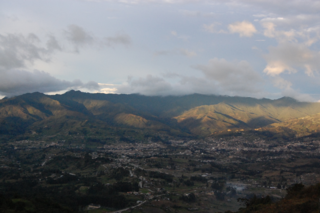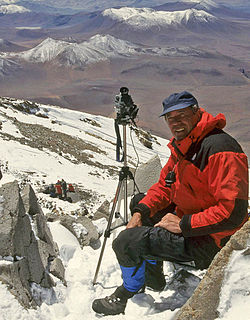
Cerro Puñay is a volcanic cone in the Chunchi Canton of Ecuador.

Chunchi Canton is a canton of Ecuador, located in the Chimborazo Province. Its capital is the town of Chunchi. Its population at the 2001 census was 12,474.

Cerro Puñay is a volcanic cone in the Chunchi Canton of Ecuador.

Chunchi Canton is a canton of Ecuador, located in the Chimborazo Province. Its capital is the town of Chunchi. Its population at the 2001 census was 12,474.
Since 2002 it has become a tourist attraction, based on the claim that at the top there is an ancient structure, referred to variously as a temple and a pyramid, possibly shaped like a Macaw. [1]

Macaws are long-tailed, often colorful New World parrots.
An alleged Quechua myth about a lost pyramid containing golden artifacts located somewhere in the Ecuadorian highlands[ citation needed ] supposedly lured both archeologists and grave robbers to the area in search of Puñay. In 2002 Christian Aguirre, a student in the School of Ecotourism in the University Politecnica de Chimborazo said that it had the formation of a giant Macaw, a bird sacred to all Andean Cultures. [2]
In an interview Christian said with regards to the many holes in the pyramid "These holes were made about 50 to 70 years ago by gringos. Nobody knows what they took but many people here say there used to be a lot of gold" [2]
In 2003, Eudoro Flores, the former mayor of the nearby city of Chunchi, was noted as saying "If you want gold, go to Puñay" but added he was impelled to promote the place for tourism to help its conservation, and prevent grave robbers from further desecrating the site. [2]
On The 21st of June 2007 an "Ancestral meeting for the arrival of new times" was held on Puñay to celebrate Inti Raymi which marks the winter solstice. The Minister for Tourism in Ecuador at the time, María Isabel Salvador, along with the main authorities of Chimborazo province and indigenous leaders from the Sierra Centro described the event as a "symbolic act of enormous importance to the Andean people". [3]

The Inti Raymi'rata is a traditional religious ceremony of the Inca Empire in honor of the god Inti, the most venerated deity in Inca religion. It was the celebration of the winter solstice - the shortest day of the year in terms of the time between sunrise and sunset - and the Inca New Year, when the hours of light would begin to lengthen again. In territories south of the equator, the Gregorian months of June and July are winter months. It is held on June 24.
With the event started the process of declaring Puñay as the "Spiritual Patrimony of the Peoples and Nations of Humanity" The declaration also strengthened the tourism and cultural potential of the sacred site to help its future conservation and protect it from further desecration. [3]

Tiwanaku is a Pre-Columbian archaeological site in western Bolivia near Lake Titicaca and one of the largest sites in South America. Surface remains currently cover around 4 square kilometers and include decorated ceramics, monumental structures, and megalithic blocks. The site's population probably peaked around AD 800 with 10,000 to 20,000 people.

Chimborazo is a currently inactive stratovolcano in the Cordillera Occidental range of the Andes. Its last known eruption is believed to have occurred around 550 A.D.

Loja, formerly Loxa and fully City of the Immaculate Conception of Loja, is the capital of Ecuador's Loja Province. It is located in the Cuxibamba valley in the south of the country, sharing borders with the provinces of Zamora-Chinchipe and El Oro, and with Peru in the south. Loja holds a rich tradition in the arts, and for this reason is known as the Music and Cultural Capital of Ecuador. The city is home to two major universities.

Riobamba is the capital of the Chimborazo Province in central Ecuador, which is located at the Chambo River Valley of the Andes. It is 200 km (120 mi) south of Ecuador's capital Quito and located at 2,754 m on the Avenue of the Volcanoes. The city is an important regional transport center as well as being a stop on the Pan-American Highway that runs through Ecuador. Riobamba stands as one of the largest cities in the central portion of Ecuador's Sierra region.

Macas is the capital of Morona Santiago province in southeastern Ecuador. The city is also the seat of the county Morona. Known as the "Emerald of the East" due to its location east of the Andes mountains, Macas lies in the Upano Valley overlooking the Upano river. The city has a population of 14,054 inhabitants and along with Tena and Puyo served under Spanish rule as one of Ecuador's main staging points for the colonization of the Amazon and the subjugation of its indigenous peoples. Beginning in the 1960s indigenous people have organized political federations and movements, and often locate the seats of their organizations in such cities and use them as central places for regional congresses. Macas has also been promoting tourism.

Johan Reinhard, is an Explorer-in-Residence at the National Geographic Society. He is also a senior research fellow at The Mountain Institute, West Virginia, a visiting professor at Catholic University, Salta, Argentina, and an honorary professor of Catholic University, Arequipa, Peru.

Tourism in Brazil is a growing sector and key to the economy of several regions of Brazil. The country had 6.36 million visitors in 2015, ranking in terms of the international tourist arrivals as the main destination in South America and second in Latin America after Mexico. Revenues from international tourists reached US$5.8 billion in 2015, continuing a recovery trend from the 2008-2009 economic crisis.

The contribution of travel and tourism to GDP was US$5,880.3bn in 2016. Tourism generated 556,135 jobs in 2016. Foreign tourist visits were predicted to have risen from 0.6 million in 2007 to 4 million in 2017. Responsible tourism became a peremptory need for Colombia because minimizes negative social, economic and environmental impacts and makes positive contributions to the conservation of natural and cultural heritage.

Tourism in Costa Rica is one of the fastest growing economic sectors of the country and by 1995 became the largest foreign exchange earner. Since 1999, tourism earns more foreign exchange than bananas, pineapples and coffee exports combined. The tourism boom began in 1987, with the number of visitors up from 329,000 in 1988, through 1.03 million in 1999, over 2 million in 2008, to a historical record of 2.66 million foreign visitors in 2015. In 2012, tourism contributed with 12.5% of the country's GDP and it was responsible for 11.7% of direct and indirect employment. In 2009, tourism attracted 17% of foreign direct investment inflows, and 13% in average between 2000 and 2009. In 2010, the tourism industry was responsible for 21.2% of foreign exchange generated by all exports. According to a 2007 report by ECLAC, tourism contributed to a reduction in poverty of 3% in the country.

Chichen Itza was a large pre-Columbian city built by the Maya people of the Terminal Classic period. The archaeological site is located in Tinúm Municipality, Yucatán State, Mexico.

Palenque is a city and municipality located in the north of the state of Chiapas, Mexico. The city was named almost 200 years before the famous nearby Mayan ruins were discovered in the 18th century. The area has a significant indigenous population, mostly of the Ch'ol people, a Mayan descendent. The city is the only urban area in a municipality of over 600 communities and it is surrounded by rainforest. However, deforestation has had dramatic effects on the local environment, with howler monkeys occasionally seen in the city itself as they look for food. While most of the municipality’s population is highly marginalized economically, working in agriculture, the Palenque archeological site is one of the most important tourist attractions for both the area and the state of Chiapas. It is the poorest major city in the state of Chiapas.

Juan Fernando Cordero Cueva is an Ecuadorian politician and architect. He was the mayor of Cuenca between 1996 and 2005. He was also Member of the Ecuadorian Congress and President of the Ecuadorian Constituent Assembly in 2008. Between 2009 and 2013 he was President of the National Assembly. From September 2014 to March 2016 he was Minister of National Defence. He is also publicly known as Corcho Cordero.

La Hoya (Argentina) is a ski resort in Chubut Province, Patagonia, southern Argentina.
Thierry Jamin (French): [tieʁi ʒamɛ̃] - born 19 December 1967 - is a French explorer and historian known for his research about Paititi and the presence of the Incas and pre-Inca civilization in the Amazonian rainforest.

Freddy Ehlers Zurita is an Ecuadorian politician. As of June 2013, he is Ecuador's State Secretary for the Presidential Initiative for the Construction of a Society of Good Life. Previously, he was Minister of Tourism from 10 May 2010 until June 2013. In 1996 and 1998, Ehlers stood candidate for the office of President of Ecuador. Between 1 February 2007 and 7 May 2010, Ehlers was the Secretary-General of the Andean Community of Nations

Ecuador–Malaysia relations are foreign relations between Ecuador and Malaysia. Ecuador has an embassy in Kuala Lumpur, while Malaysia has an honorary consul in Quito. Both countries are also members of the Non-Aligned Movement.

Pukara, Puno is a town in the Puno Region, Lampa Province, Pucará District, Peru. It is located to the north-west of Lake Titicaca.
María Constanza Ceruti is an Argentinian high-altitude archaeologist and anthropologist who has done more than 80 field surveys, most of them with National Geographic teams in Argentina, Chile, Bolivia, Ecuador and Peru. She specializes in excavating Inca Empire ceremonial centers on the summits of Andean mountains. Her most important finding are the Llullaillaco Mummies, the best preserved mummies in the world according to the Guinness Book of Records. She's the only archaeologist specialized in the field of High Mountains. She's also a researcher in the CONICET, director of the Institute of High Mountain Research at the Catholic University of Salta and teacher of a class that bears her name: Sacred Mountains - Constanza Ceruti.

The Buraco das Araras Private Natural Heritage Reserve is a privately operated conservation area in the state of Mato Grosso do Sul, Brazil. It takes its name from the Buraco das Araras, a large sinkhole that is the main feature of the reserve.

The Northern Andean páramo (NT1006) is an ecoregion containing páramo vegetation above the treeline in the Andes of Colombia and Ecuador. In the past, when the climate was cooler, the treeline and the páramo units were lower and the units were connected. During the present warmer Holocene epoch the páramos have migrated uphill, shrinking and becoming isolated. They contain many rare or endangered species, some of them restricted to a narrow area of one mountain or mountain range. The ecoregion is relatively well preserved, but faces threats from over-grazing and farming.